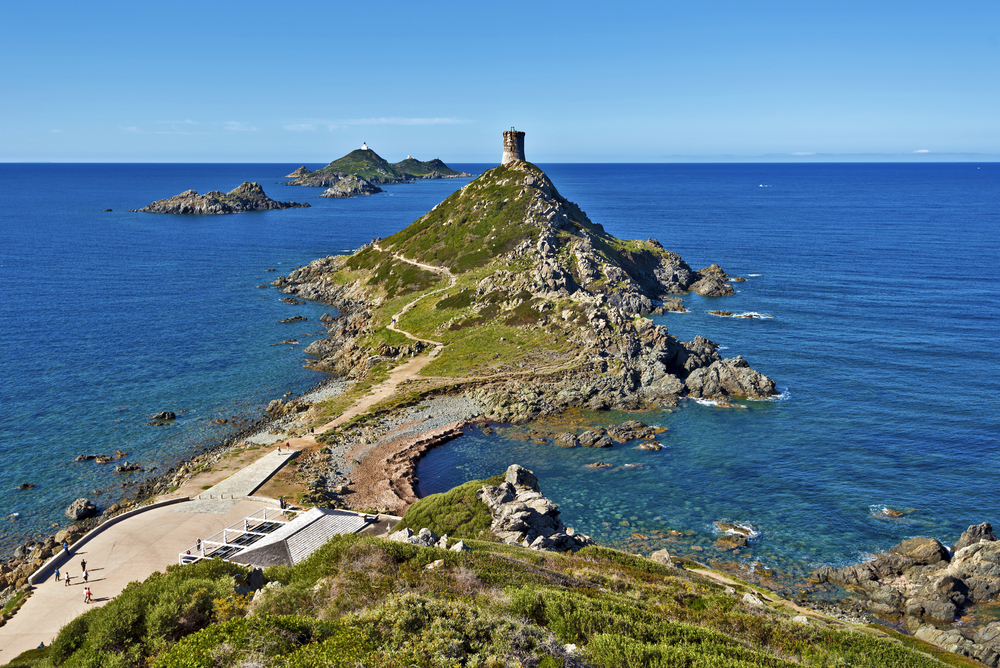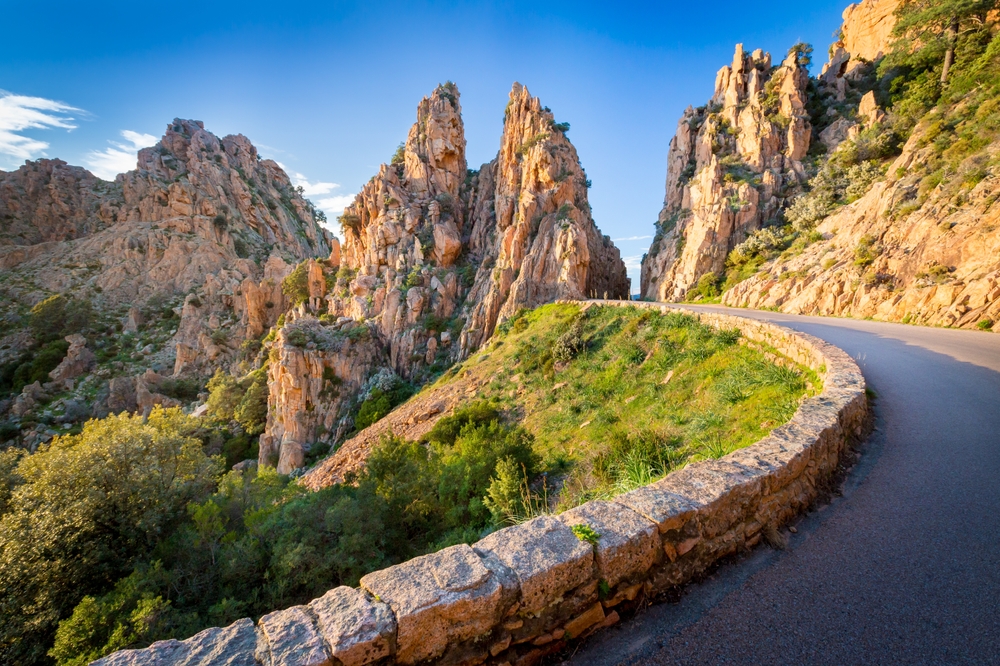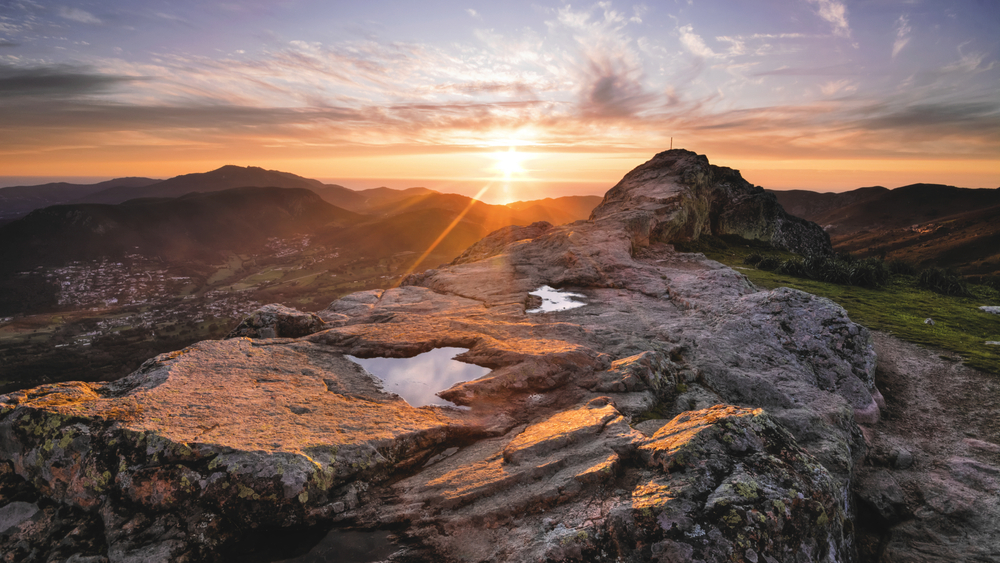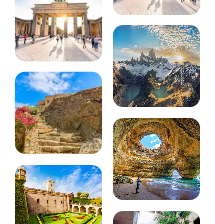15 not-to-be-missed excursions around Ajaccio

Discovering the area aroundAjaccio means taking an exceptional journey between the crystal-clear sea and majestic mountains. The imperial city of Napoleon Bonaparte is the ideal starting point for exploring the natural and heritage treasures of southern Corsica. From the Sanguinaires islands to the calanques of Piana, via the hilltop villages of the hinterland, each excursion reveals a unique facet of the Isle of Beauty. Whether you’re a hiking enthusiast, a history buff or simply looking for breathtaking scenery, these 15 excursions around Ajaccio promise unforgettable memories in the heart of the Mediterranean.
200 audioguided tours for cities all around the world
Download1. The Sanguinaires islands and Pointe de la Parata

Just 12 kilometres from Ajaccio, the Sanguinaires Islands are undoubtedly one of the most emblematic excursions around the imperial city. This exceptional site, designated a Grand Site de France, owes its evocative name to the blood-red colour its porphyry rocks take on at sunset. The archipelago is made up of four islets: Mezu Mare (the largest), Isolotto, Cala d’Alga and Porri.
The Pointe de la Parata is a privileged land-based access point to this natural spectacle. The signposted path, accessible to all the family, leads up to the 16th-century Genoese tower that watches over this rocky promontory. From this exceptional vantage point, the panorama takes in the entire Gulf of Ajaccio and stretches as far as the Corsican mountains. The more courageous can climb the path leading up to the tower to enjoy an even more spectacular view.
To fully discover this natural jewel, visitors have several options: boat trips to get close to the islets and observe the marine wildlife, or hiking along the customs path that runs along the wild coastline. Photography enthusiasts will find an exceptional playground here, especially during the famous sunset that sets the whole archipelago ablaze.
Also read the Ajaccio guide :
- Ajaccio in 1 day: 18 things to do and see on foot
- What to see and do in South Corsica around Ajaccio
- Top 10 culinary specialities in Ajaccio
- What are the best things to do in Ajaccio?
- The best hotels to stay in Ajaccio
- Top 6 Corsica seaside campsites
- Visit the Sanguinaires islands in Corsica
2. The calanques of Piana and the Gulf of Porto

Just 71 kilometres from Ajaccio, the Calanques de Piana are one of Corsica’s most spectacular natural sites, and a UNESCO World Heritage Site. These exceptional geological formations, carved out of red porphyry by erosion, create a lunar landscape of striking beauty. The phantasmagorically shaped rocks, nicknamed “tafoni”, create a fairytale setting in which the imagination can recognise animals, faces and all manner of shapes.
The village of Piana, perched at an altitude of 438 metres, is a must-see on this tour. Listed as one of the most beautiful villages in France, it offers an exceptional panorama of the Gulf of Porto and the surrounding creeks. Its pink granite houses and Mediterranean vegetation create a picture of perfect harmony.
There are several hiking trails to explore these natural wonders. The Capu Rosso path leads up to a Genoese tower offering a breathtaking view of the sea and cliffs. The more accessible Muleteers’ Path winds through the tafoni and allows you to admire these natural sculptures up close. For a complete experience, the excursion can be combined with a visit to the Scandola nature reserve and the village of Girolata, which are only accessible by boat.
3. Mount Gozzi

Dominating the Ajaccio hinterland from a height of 714 metres, Mount Gozzi is one of the most remarkable lookouts in the region. This imposing mass of red granite, visible for miles around, symbolically marks the transition between the coast and the Corsican mountains. Its distinctive silhouette makes Gozzi a major geographical landmark in the Ajaccio landscape.
The ascent of Mount Gozzi, a 45-minute walk from the village of Appietto, rewards walkers with an absolutely exceptional 360-degree panorama. From the summit, you can see the entire Gulf of Ajaccio, the Sanguinaires islands, the Gravona valley and, on a clear day, the snow-capped peaks of central Corsica. This family-friendly hike, suitable for all ages with a minimum of physical fitness, offers one of the most beautiful views of Ajaccio and the surrounding area.
The wealth of flora and fauna on Mount Gozzi adds a naturalistic interest to this excursion. The Corsican maquis displays all its diversity here, with arbutus, myrtle, rockrose and wild lavender. Botany enthusiasts will be able to observe numerous endemic species, while birdwatchers will have the chance to spot buzzards, kestrels and other birds of prey nesting in the rocky crevices.
4. Propriano and the Gulf of Valinco
Situated 70 kilometres south of Ajaccio, Propriano boasts an authentic seaside atmosphere and a privileged location in the heart of the Gulf of Valinco. Despite its modest size, this charming seaside resort regularly welcomes cruise ships and ferries, testifying to its maritime importance. Its colourful marina, lined with restaurants and cafés, invites you to stroll around and discover Corsican specialities.
Propriano’s beaches are one of its main attractions. The Lido beach, with its fine sand and turquoise waters, stretches for several kilometres and offers all the facilities you need for a relaxing day out with the family. The wilder Baracci beach has an unspoilt setting, while Capu Laurosu offers intimate coves lined with rocks sculpted by the waves.
An excursion to Propriano can be enhanced by a visit to the surrounding prehistoric sites, in particular Filitosa, one of the most important megalithic sites in the western Mediterranean. These 4,000-year-old statue-menhirs bear witness to Corsica’s rich archaeological heritage and add a fascinating historical dimension to this trip to the south of the island.
5. The ridge trail
A veritable institution among the walks around Ajaccio, the sentier des crêtes is one of the most popular with locals and visitors alike. This 12-kilometre route, which starts in the Bois des Anglais on Avenue de Verdin, winds its way through the mid-range Corsican mountains over a difference in altitude of almost 600 metres. The whole loop takes around 4 hours to complete, and rewards hikers with exceptional panoramic views over the Gulf of Ajaccio.
The trail winds its way through different Mediterranean ecosystems, offering a real life-size botany lesson. The dense undergrowth reveals its fragrant essences: immortelle, wild rosemary, mastic and arbutus make up a typically Corsican olfactory symphony. The route is dotted with vantage points revealing the bay of Ajaccio from different angles, the red-tiled residential districts and the Mediterranean horizon punctuated by the Sanguinaires islands.
This hike is an excellent alternative for those wishing to discover Corsica’s natural beauty without leaving the capital. The accessibility of the starting point from the city centre makes it an ideal half-day or full-day excursion, depending on the pace you choose. To make the most of this experience, we recommend setting off early in the morning to avoid the summer heat and take advantage of the best light.
6. Capo di Muro and its Genoese tower
45 kilometres south-east of Ajaccio, Capo di Muro reveals one of the most remarkable Genoese towers on the Corsican coast. This 16th-century fortification has the unique feature of being accessible from the inside, unlike most of the other towers in the Gulf. Perched on its rocky promontory, it offers an exceptional view of both sides of the cape, embracing both the east and west coasts.
The tower overlooks the charming little village of Acqua Doria, an authentic hamlet where time seems to have stood still. This picturesque village, with its traditional stone houses and terraced gardens, bears witness to the Corsican art of living far from the tourist crowds. The narrow streets invite you to take a stroll, revealing typical architectural details and views of the deep blue sea.
An excursion to Capo di Muro can be enhanced by the discovery of small, unspoilt coves nestling at the foot of the cliffs. These confidential beaches, accessible via steep paths, offer an idyllic setting for a swim in the crystal-clear waters. The richness of the seabed also makes it a popular spot for snorkelling enthusiasts, who can observe the preserved marine fauna.
7. Villanova and the Bomba valley
Nestling between Ajaccio and Alata, the small commune of Villanova remains one of the best-kept secrets around the Corsican capital. This charming locality, often overlooked by mainstream tourist routes, is nonetheless the starting point for some remarkable excursions through the Bomba valley. The eponymous path winds its way down to this verdant valley, offering changing views of the Gulf of Lava and its turquoise waters.
Hiking in the Bomba valley reveals an exceptional geological heritage with the presence of numerous tafoni, natural shelters carved into the granite that served as refuges for our prehistoric ancestors. These rock formations, sculpted by thousands of years of erosion, create surprisingly shaped cavities that bear witness to ancient human occupation of the region. Some of these shelters still preserve traces of occupation, fragments of pottery or carved tools that speak of the archaeological wealth of the site.
The path also offers magnificent views of Lava beach, one of the most popular in the Ajaccio region. This long stretch of fine sand, protected from the prevailing winds by the shape of the bay, enjoys a particularly mild microclimate. The descent to this beach from Villanova is a pleasant alternative to the excursion, combining a cultural hike with relaxation at the seaside.
8. The Isolella peninsula
A 35-minute drive from Ajaccio, the Isolella peninsula is one of the most unspoilt natural gems on the south coast. This spit of land jutting out into the Mediterranean is home to an exceptional beach, regularly ranked as one of the most beautiful in Corsica. The immaculate white sand contrasts with the striking turquoise waters, creating a picture-postcard landscape reminiscent of the Caribbean in the heart of the Mediterranean.
The Genoese tower of Isolella, standing at the tip of the peninsula, has watched over this natural paradise for centuries. This stone sentinel offers a privileged vantage point from which to gaze across the bay of Cupabia to the north and Propriano to the south. The climb up to the tower, although short, rewards you with an exceptional panorama of the surrounding gulfs and the mountains inland.
The ecological richness of Isolella makes it a particularly popular spot for nature lovers. Mediterranean vegetation flourishes here, from maritime pines to junipers and the tamarisk trees that line the beach. The exceptionally transparent seabed is home to a wealth of aquatic fauna that snorkellers can easily observe from the shore. The Posidonia meadow that stretches out to sea contributes to the purity of these crystal-clear waters.
9. Tolla lake
Nestling in the mountains 32 kilometres from Ajaccio, Lac de Tolla offers a complete change of scenery with its surprising alpine landscapes in the heart of the Mediterranean. This artificial lake, created by a dam on the Prunelli river, covers 500 hectares in a mountain setting of striking beauty. The deep blue waters reflect the surrounding peaks, creating a natural mirror of absolute serenity.
The Scaledda lookout is one of the most spectacular vantage points on the lake and the surrounding area. From this natural observation platform, the panorama takes in the whole lake, dominated by the majestic silhouette of Petra Alta, which rises to over 1,000 metres. This striking contrast between the gentleness of the lake and the ruggedness of the rocky ridges perfectly illustrates the diversity of Corsican landscapes.
Water sports are one of the main attractions of Lac de Tolla. Pedalos can be hired for families to explore the lake in a fun way, while the more sporty can try their hand at kayaking or sailing. You can also fish here, as the lake is stocked with trout and carp. A number of hiking trails run along the shore, offering different levels of difficulty to discover this mountain oasis far from the hustle and bustle of the coast.
Download the audio tour to discover Ajaccio on foot and on your own
Before setting off to discover the surrounding area, let theAjaccio sightseeing itinerary be your guide as you explore the Corsican capital. This 6-kilometre audio tour takes you through 18 major places of interest, from Napoleon’s birthplace to the gardens of the Palais Fesch, via the citadel and the Tino Rossi harbour. Each stop reveals the secrets of the imperial city, with historical commentary and anecdotes to enhance your understanding of this fascinating city.
10. Porticcio and the south shore of the gulf
Just 18 kilometres south of Ajaccio, Porticcio is the leading seaside resort in southern Corsica. Developed in the 1960s, this modern seaside resort has preserved its authentic Mediterranean charm while offering all the amenities of a top tourist destination. Its privileged location on the southern shore of the Gulf of Ajaccio gives it exceptional views over the Corsican capital and the surrounding mountains.
Porticcio’s beaches are one of its main attractions. The main beach, several kilometres long, rolls out its fine sand facing the crystal-clear waters of the gulf. The more secluded Agosta beach has a wilder setting and a particularly rich seabed, making it an ideal spot for scuba diving and snorkelling. The wide range of water sports on offer – jet-skiing, parasailing, sailing – caters for all marine enthusiasts.
An excursion to Porticcio can be enhanced by a visit to the Capitello tower, a Genoese vestige perched on a rocky promontory. This historic fortification provides an exceptional vantage point from which to observe the whole of the Gulf of Ajaccio, making it an ideal hiking destination for all the family. The path leading to it runs through unspoilt scrubland dominated by immortelle, rockrose and myrtle, offering a welcome natural break from the pleasures of the seaside.
11. Bastelica and the Val d’Ese
Perched at an altitude of 800 metres, 38 kilometres from Ajaccio, the village of Bastelica reveals a little-known face of Corsica, that of the mid-mountain alpine landscape. This authentic village, home of the revolutionary Sampiero Corso, has managed to preserve its mountain character, with its shale houses and cobbled streets that bear witness to centuries of adaptation to the harsh winter climate. The atmosphere here is radically different from that on the coast, inviting you to discover a secret and unspoilt Corsica.
The Sant’Albertu waterfall is one of the region’s natural wonders. This spectacular waterfall, fed by mountain water, plunges dozens of metres into a rocky amphitheatre of striking beauty. The access path, while requiring a little effort, rewards you with the freshness of this exceptional site where the pure water of the Corsican mountains reveals all its crystalline purity.
The Val d’Ese and its pozzines offer a complete change of scenery, with high mountain landscapes that are unique in the Mediterranean. These high altitude wet meadows, veritable natural gardens dotted with ponds and streams, are home to an exceptionally rich endemic flora. In winter, this region reveals a different face with the Val d’Ese ski resort, astonishing proof that Corsica can also be decked out in white and offer the pleasures of winter sports just a few kilometres from sun-drenched beaches.
12. Cargèse, the ancient Greek city
Just 49 kilometres from Ajaccio, Cargèse fascinates visitors with its unique history and dominant position on Corsica’s west coast. This former Greek colony, founded in the 17th century by refugees from the Peloponnese, has preserved a unique architectural heritage with its two churches facing each other: the Latin church and the Greek Orthodox church, which bear witness to the coexistence of the two religious communities. This hilltop village offers exceptional views over the gulfs of Sagone, Lava and Porto.
The Punta di Cargèse is an accessible family walk that rewards you with breathtaking views of the sea and surrounding mountains. This natural promontory, easily reached on foot from the village, allows you to take in at a glance the vastness of the Mediterranean, punctuated by the Sanguinaires islands to the south and the majestic Capo Rosso to the north. Here, Mediterranean vegetation unfolds in all its splendour, with rare species and intoxicating fragrances.
The excursion to Cargèse can be extended to the spectacular Capo Rosso, one of Corsica’s most photographed sites. This red porphyry cliff plunges vertically into the sea from a height of 300 metres, offering breathtakingly beautiful scenery. The hike up to the Genoese tower that crowns the cape is an unforgettable adventure, rewarded by one of the island’s most beautiful panoramas of the Piana creeks and the Scandola reserve.
13. Tiuccia and the Liamone beach
Situated 29 kilometres from Ajaccio, the small village of Tiuccia is well worth a visit, despite its apparent discretion. This coastal village, which is often passed through without stopping, nevertheless reveals remarkable natural treasures to those who take the time to discover it. Its privileged location between the sea and the mountains makes it an ideal starting point for a variety of excursions in the surrounding area, combining relaxation at the seaside with heritage discoveries.
The Capigliolo headland and its Genoese tower offer an imposing view of the Gulf of Liscia on one side and the immense Liamone beach on the other. This perfectly preserved 16th-century fortification bears witness to the strategic importance of this site, which kept watch over the approaches to the sea. The ascent to the tower, although short, rewards you with a 360-degree panorama of strikingly diverse landscapes, from intimate coves to vast stretches of sand.
The Liamone beach stands out for its special features in the Corsican coastal landscape. This long stretch of sand, swept by regular winds, generates waves that are unusual in the Mediterranean, creating a permanent spectacle appreciated by surf and windsurf enthusiasts. Sunsets from this west-facing beach offer magical moments when the fiery sky reflects off the golden waves, creating a romantic atmosphere unique to the Corsican coast.
14. The Chiavari forest
36 kilometres from Ajaccio, the Chiavari forest reveals an exceptional forest ecosystem in the commune of Coti-Chiavari. This forest of holm oaks and maritime pines offers a haven of freshness and serenity, contrasting with the summer aridity of the surrounding scrubland. The waymarked paths that criss-cross the forest are ideal for relaxing family walks in the heart of this unspoilt natural environment, whether on foot or by bike.
Walkers will discover the remains of theformer penitentiary and its historic esplanade. This historic site, now overgrown, bears witness to the region’s prison past and offers a remarkable view of the sea. The esplanade, now restored and landscaped, provides a natural vantage point from which to contemplate the vastness of the Mediterranean and the islands off the coast, in a peaceful setting conducive to meditation.
The excursion into the Chiavari forest can be extended with a visit to the Mare é Sole beach, located to the south of the forest. This secluded beach, accessible via a path through the forest, boasts crystal-clear waters of exceptional purity in an unspoilt wilderness setting. The combination of forest and beach makes this excursion a complete experience, combining the pleasures of hiking in the undergrowth with those of swimming in crystal-clear waters far from the summer crowds.
15. The hilltop villages of the hinterland
The Ajaccio hinterland is home to a number of hilltop villages that bear witness to the Corsican mountain way of life and offer authentic escapes from the hustle and bustle of the coast. Afa, Alata, Appietto and Tavaco are just some of the places you can visit to discover traditional Corsica. These villages, clinging to the sides of the mountains, offer exceptional panoramic views of the Gulf of Ajaccio and the surrounding valleys.
The village ofAfa, located around ten kilometres from Ajaccio, has a charm all of its own, with its unspoilt authenticity and breathtaking views over the Corsican capital. Its cobbled streets, traditional stone houses and Baroque church make up a harmonious architectural ensemble typical of Corsican hilltop villages. The natural belvedere offered by its position allows you to admire the entire Gulf of Ajaccio in a bucolic setting where time seems to have stood still.
Bocognano, at a higher altitude, reveals strikingly beautiful mid-mountain landscapes, with centuries-old chestnut groves and traditional sheepfolds. This village, famous for having witnessed the birth of some of Corsica’s most historic figures, has preserved a remarkable architectural heritage with its tower-houses and winding lanes through the cultivated terraces. A trip to these villages is a chance to discover an ancestral way of life, where people have adapted harmoniously to the constraints of the mountainous terrain while preserving their age-old traditions. To enhance your discovery of the region, don’t hesitate to visit Ajaccio with the Navaway itinerary, which will reveal all the secrets of the imperial city.
In conclusion, the excursions around Ajaccio offer an exceptional diversity that reflects all the richness of the Isle of Beauty. From the emotion of the sunsets over the Sanguinaires islands to the wonder of the calanques of Piana, not forgetting the serenity of the hilltop villages and the coolness of the high altitude forests, each excursion reveals a unique facet of Corsica. These 15 excursions are all invitations to explore an exceptional territory where nature has sculpted landscapes of breathtaking beauty. Whether you prefer seaside pleasures, cultural discoveries or mountain hikes, the area around Ajaccio will meet all your expectations and leave you with lasting memories of your stay in Corsica. To perfect your knowledge of the region, theaudio-guided itinerary of Ajaccio will allow you to discover all the treasures of the capital of Southern Corsica on your own.
FAQ
When is the best time to take these excursions around Ajaccio?
The ideal period is from April to October, with a preference for May-June and September-October to avoid the heat and crowds of summer. Winter is still a good time for hiking in the mountains, but some high-altitude roads may be closed.
Do you need a car for all these excursions?
A car is recommended for most excursions, although some, such as the Sanguinaires islands or the sentier des crêtes, are accessible by public transport or on foot from Ajaccio. Hiring a car offers greater flexibility for exploring the hinterland.
Are these excursions suitable for families with children?
Most of the excursions on offer are suitable for families. The beaches of Porticcio and Isolella and the hilltop villages are perfect for children. Some hikes, such as Mount Gozzi, require a minimum level of physical fitness, but are accessible to children aged 6-7 and over.
Is it possible to combine several excursions in one day?
Some nearby excursions can be combined: Porticcio and Isolella, the hilltop villages between them, or Cargèse with Capo Rosso. However, it’s best to devote a whole day to the more remote sites, such as Piana or Propriano, to make the most of them.
200 audioguided tours for cities all around the world
Download
